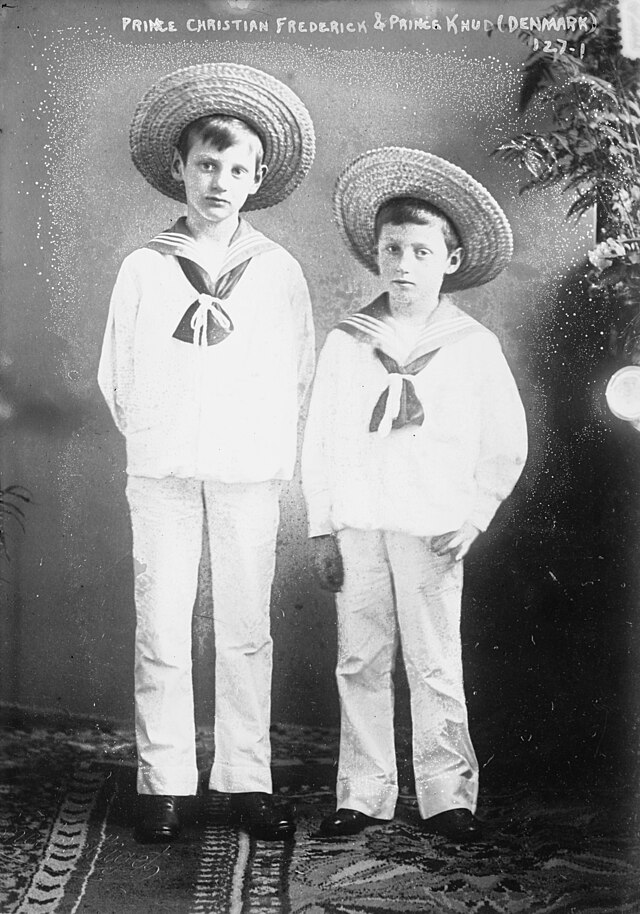by Susan Flantzer © Unofficial Royalty 2015

Count Ingolf of Rosenborg with his wife Countess Sussie; Credit – Wikipedia
Count Ingolf of Rosenborg (Ingolf Christian Frederik Knud Harald Gorm Gustav Viggo Valdemar Aage) was born a Prince of Denmark on February 17, 1940, at Sorgenfri Palace in Lyngby-Taarbæk, Denmark, north of Copenhagen. He was the elder son and the second of the three children of Prince Knud of Denmark (son of King Christian X) and Princess Caroline-Mathilde of Denmark (daughter of Prince Harald of Denmark who was a son of King Frederik VIII). Ingolf had an elder sister and a younger brother:
- Princess Elisabeth of Denmark (1935 – 2018), unmarried
- Prince Christian of Denmark (1942 – 2013), married Anne Dorte Maltoft-Nielsen without consent, lost his royal title, became His Excellency Count Christian of Rosenborg
In 1947, Ingolf’s grandfather King Christian X died and his uncle King Frederik IX acceded to the throne. At that time, only males were allowed to be in the line of succession. King Frederik had three daughters, so Prince Knud, Ingolf’s father and the King’s only brother, was the heir presumptive and Ingolf was second in the line of succession. As the early years of King Frederik’s reign passed and no baby prince was born to King Frederik, it seemed likely that Knud would succeed his brother as King and that eventually, Ingolf would be King.
Because of the unpopularity of Prince Knud and the belief that the 1853 succession law was outdated, the Danish Act of Succession was adopted on March 27, 1953. The new law allowed for female succession if the monarch had no sons. This enabled the daughters of King Frederik IX to supplant their uncle Knud and cousin Ingolf in the line of succession. Instead of being first and second in the line of succession, Knud and Ingolf were now fourth and fifth behind Margrethe, Benedikte, and Anne-Marie, King Frederik IX’s daughters. To compensate for the change in the succession, Knud was given the title Hereditary Prince of Denmark, and both Knud and his elder son Ingolf were granted fixed annuities and additional flexible annuities for life. In 1972, Frederik’s eldest daughter succeeded him as Queen Margrethe II and in 2009 the succession law was changed to allow for the succession of the firstborn child regardless of gender.
In 1968, Ingolf decided to marry Inge Terney (1938 – 1996), an untitled commoner. He decided to marry without seeking King Frederik IX’s permission because he had little chance of succeeding to the throne and it was expected that the King would not give permission. This would mean that Ingolf’s succession rights would be forfeited. The title Count of Rosenborg had been granted to other Danish princes who had relinquished their position within the Royal Family upon marrying without official consent from the monarch. Before his son’s wedding, Prince Knud tried to convince his brother that Ingolf should be allowed to retain his royal title after marriage, but King Frederik IX refused. After Ingolf’s wedding on January 13, 1968, he was styled His Excellency Count Ingolf of Rosenborg. For a history of the title Count of Rosenborg, see Unofficial Royalty: The Danish Counts of Rosenborg.
After his first wife died in 1996, Ingolf married lawyer Sussie Hjorhøy Pedersen (born 1950) on March 7, 1998, at the City Hall in Egtved, Denmark. Ingolf had no children from either marriage and lives at his estate Egeland in Egtved, Denmark. Ingolf and his wife attend major events of the Danish Royal Family.
This article is the intellectual property of Unofficial Royalty and is NOT TO BE COPIED, EDITED, OR POSTED IN ANY FORM ON ANOTHER WEBSITE under any circumstances. It is permissible to use a link that directs to Unofficial Royalty.






















